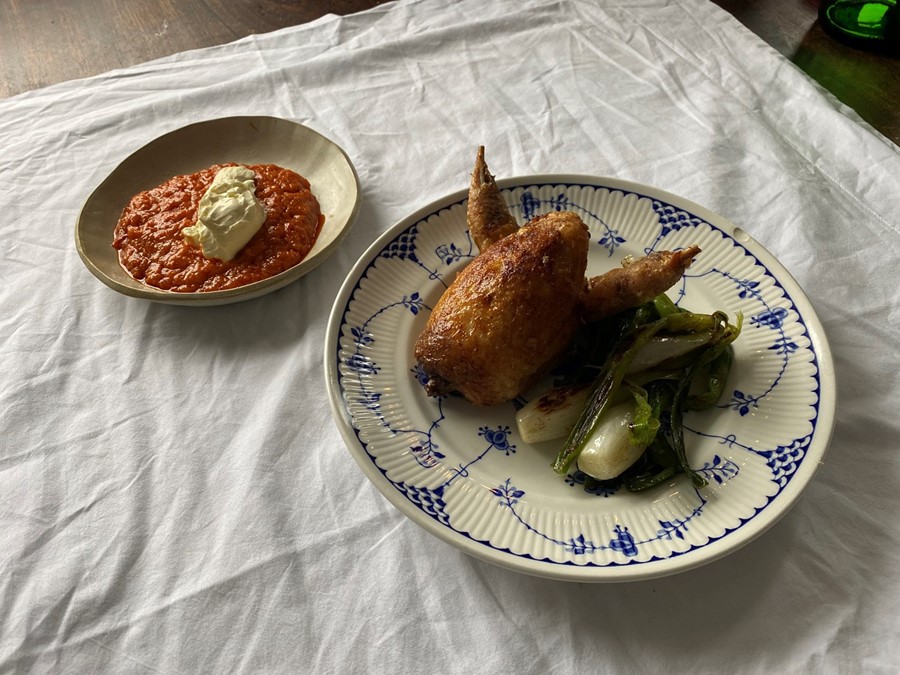From restaurants to social media, the way food looks is changing. What does this say about how we’re eating and living amid the pandemic?
A few years ago, London-based food photographer Jessica Wang could comfortably shoot ten different shots of a single plate of food. Now, she’s noticing that a much more pared-back approach to plating is changing the way she works. “It’s almost presenting itself as a different challenge,” says Wang, “because everything is so minimal now.” Gone, from her perspective, are the edible flowers and other visual flourishes both restaurateurs and diners associate with high-end fare and French nouvelle cuisine; many plates are arriving to the table with a single subject centred in the middle.
One recent example is chef Florence Knight’s riff on Chou Farci at lauded restaurant Sessions Arts Club in Clerkenwell: the dish resembles a single orb of cabbage, surrounded by a speckled sauce. Cut into it, and you’ll find rabbit and Italian sausage, cleverly masked.
But it’s not just restaurant food that’s leaning towards an unembellished aesthetic. Online, plates on my Instagram feed – taken by chefs, home cooks, food stylists or diners – are looking much more lo-fi. The photos themselves have also shifted gears from bright, high-contrast birds-eye views to seemingly unfiltered frames filled with negative space.
This paradigm “is a reaction to the moment that came before it,” says Laila Gohar, a New York-based artist whose playful (and at times monastic) tables of carefully stacked fruit, carved butter, and boob mochi are favourites among the fashion and art set. “What came before in terms of food photography was the hyper-saturated, intensely photographed food,” she adds, referencing food publications like Bon Appétit. Gohar says that, in the wake of the pandemic, people are craving a pared-back, comforting approach.
Simple food, of course, is nothing new. For decades, restaurants like London’s River Café and St John, California’s Chez Panisse and writers from Nigel Slater to Marcella Hazan have been proponents of a produce-led way of cooking, though some recipes are inevitably more complicated than others. And in recent years, calls for “ugly delicious” and beige food have pushed for flavour over form. But more than ever, this mood speaks to people living amid global crises who are in need of comfort, nostalgia and ease.
These are all things chef Max Rocha is looking to provide at Hackney’s Café Cecilia, which opened late last year. On the menu are childhood favourites like crab on soda bread, served simply just as his Irish grandmother would when he was young. Rocha, who cut his teeth at St John, The River Café and Skye Gyngell' Spring, was trained in the art of seasonal simplicity. The fact that chefs like him (who worked and effectively studied under these influential institutions) are now starting their own businesses, also explains the proliferation of a modern British approach to food and plating, says Gohar.
With chefs like Rocha, people know what they’re getting. “There are no tuiles or foam or anything you can hide behind,” he says. Of course, minimal presentation often belies big flavours and lots of preparation – a minimally plated, but extremely flavourful dish can be extremely impactful. But “there are only so many ways you can plate a pork chop,” he says, and there’s a comforting lack of guesswork involved when placing an order at his spot.
A longing for comfort and homely meals also dovetails with a desire for transparency, when it comes to where our food comes from. “So much is being done to so much of our food – lab-grown meats, hydroponic leafy greens and huel,” says Charles Spence, food psychologist and author of Gastrophysics: The New Science of Eating. In the branded food space, Spence has observed “nostalgia brands” releasing an increasing number of products to tap into current demand. “To the extent that those foods go back to our childhood … The home cooking, the authentic – it makes sense.”
At the same time, our disenchantment with highly manicured plates is hard to seperate from our attitudes towards traditional fine dining, 20-course tasting menus and the cuisines we deem valuable in general. The kinds of restaurants we want to eat at are changing, says Rocha, and high-end establishments aren’t as in demand as they used to be.
“The world has witnessed a kind of democratisation of fine dining, and of ‘foodie’ culture more generally,” writes Lewis Bassett in a 2021 edition of the newsletter Vittles. “In the UK, the popularity of eating out has increased year on year, while the sites of contemporary culinary fashion are no longer shrines to a stuffy French tradition.”
Even Wang, whose job it is to photograph food, hasn’t been to more than a handful of restaurants since March 2020. If anything, she’s seeing restaurants ditch professional cameras on social media and posting images shot by the team, blurry snaps, sub-par lighting and all. “I think it appeals to us as target audiences more now.”
